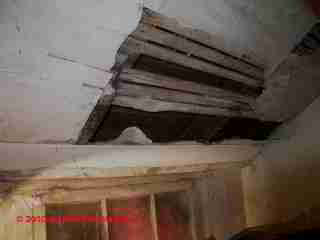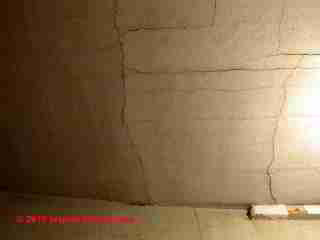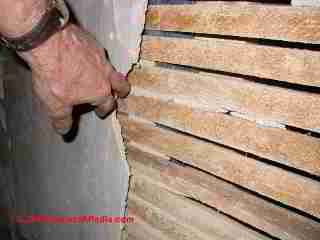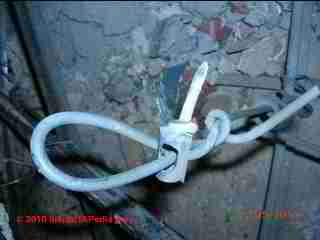 Loose Plaster Ceiling & Wall Hazards
Loose Plaster Ceiling & Wall Hazards
Falling Plaster Injury Risk
- POST a QUESTION or COMMENT about the dangers of injury from loose or falling plaster.
Loose or collapsing plaster ceiling hazards:
Here we describe the hazards of loose, falling plaster, and we give the basic steps in a procedure for checking for loose plaster in buildings.
We include some tips for repairing or securing loose plaster.
We illustrate plaster coatings, cracks, bulges, hazards. Plaster ceiling collapse hazards & photographs.
In this article series we describe and discuss the identification and history of older interior building surface materials such plaster, plaster board, split wood lath, sawn lath, and expanded metal lath, Beaverboard, and Drywall - materials that were used to form the (usually) non-structural surface of building interior ceilings and walls.
InspectAPedia tolerates no conflicts of interest. We have no relationship with advertisers, products, or services discussed at this website.
- Daniel Friedman, Publisher/Editor/Author - See WHO ARE WE?
Loose Plaster is Unsafe, Especially Loose, Falling Plaster Ceilings
Watch out: for loose plaster that can fall and injure building occupants.
If ceiling plaster is bulged and moves when you apply gentle pressure to it, chances are that the plaster keys, the protruding plaster that oozed between the plaster lath strips to mechanically secure the plaster surface in place, have broken off.
On the other hand, some "bulged"-looking plaster may be soundly secured, as we describe
Wood Lath Ceiling Collapse Photographs
Our loose plaster photo at below left shows wall plaster that was quite loose and whose plaster ears had broken away. Some renovators use the term "rotted plaster" or "rotten plaster" but of course since we're talking about a cementious material, not organic wood, "rot" is a euphemism for deteriorated.
Our loose plaster ceiling photo (below right) shows an unsafe building ceiling at risk of falling.

Plaster in this condition can easily fall away. While small areas of loose plaster can be successfully re-adhered using plaster washers and screws, a better (but more costly) repair is to remove the loose plaster entirely and re-plaster the section properly.
At below are two photographs of plaster ceilings in the attic that has already fallen away in two older homes.
You may also enjoy noticing the pit-sawn kerf marks on some of the plaster lath of this older home in the photo at below left, and the hand-wrought iron hook in the photo at right. .

Watch out: often the framing supporting plaster ceilings in homes built before 1900 was sized to be just strong enough to support the weight of the plaster itself. Such ceiling structures were not intended to support the weight of a curious home owner or home inspector.
Basic Steps in Checking for Loose Plaster Ceilings or Walls
1. Visual inspection from the finished ceiling or wall side:
is the plaster visibly cracked, bowed, bulged. Plaster may be cracked but still securely bonded to the supporting lath, but if the plaster is also bowed or bulged then it may have come loose from its support system. Stains indicating a history of leaks increase that risk.
Watch out: of course if you see that some plaster has already fallen away from the ceiling or wall then we know that there is damage and there is risk of additional falling plaster.
2. Visual inspection of a plaster ceiling from the attic side:
If the ceiling is accessible safely from above, move back insulation and inspect the attic side of the ceiling. Particularly if you can see the wood lath, you can see first-hand if the lath is still well secured to the supporting ceiling joists, and you can certainly see as well whether or not the plaster "ears" are broken or intact.
By "plaster ears" I refer to the plaster that oozes beween the wood lath strips, then curls over so that as the plaster dries and hardens those ears form a mechanical attachment to the lath system.
A metal lath plaster ceiling also will show plaster having pressed through the lath openings and then hardened to form a mechanical connection that is much stronger than mere "adhesion" to the lath surface.
3. Gentle pushing or prodding of suspect plaster:
if you can push against the plaster and it moves upwards (ceilings) or inwards towards the walls (walls) then the plaster is loose, has lost its mechanical connection and is in danger of falling.
Expanded Metal Lath Plaster Ceiling Catastrophic Collapse Case
Watch out: Plaster ceilings in newer buildings are not immune from collapse either, as you'll see by the catastrophic ceiling collapse shown just below. This plaster ceiling was applied on expanded metal lath. The lath was wired to steel pipes or bars that in turn were hung from a smaller number of steel supports.
The final steel supports were hung from wire ties connected to fasteners that had been "pin-shot fasteners" shot into the sides of concrete ceiling joists.
The combination of several factors led to this ceiling collapse:

The combination of several factors led to this ceiling collapse:
- An insufficient number of fasteners was used to secure the whole suspended ceiling structure to the concrete beams above - considerably less than called for the industry standards including those of the Hilti Corporation, a producer of pin shot fasteners. This was the most apparent and most significant cause of this ceiling collapse in our opinion.
- The pin shot fasteners used as ceiling hangers may have been of the wrong type for this application and may have been improperly loaded.
- It is possible that the shot fasteners used to provide fasteners for the wire hangers supporting the ceiling were not properly installed, allowing some of them to separate from the concrete.
For example if pins were shot directly "up" into the underside of joists or beams when they were intended to be shot into beam or joist sides, they may have lacked sufficient friction to remain in place, being later pulled out from the downward force of the weight of the ceiling. - There was no perimeter support for the ceiling.
- We considered the possibility that damp conditions in the building may have contributed to fastener loosening or deterioration, but the absence of rust in the field photos argues against that factor.
- Nearby demolition for building renovation work created vibrations sped or precipitated this collapse that could have occurred at any time.
Typical Design & Construction of Suspended Plaster Ceilings
According to Van Den Branden and Hartsell, a typical suspended wire-mesh based plaster ceilings using hangers, carriers, and furring channels (such as described by Inland Steel Products Co.,) typically used No. 8 galvanized wire, though other wire sizes, rods, and flat iron were also used:
- #8 galvanized wire. Wire in gauges 12,10, 9, 8, 7, and 6 sizes. Common #8 steel wire is rated to carry 16 sq.ft. of completed ceiling per hanger (presuming that the ceiling weight and thickness are also to standard specifications).
- 3/16" pencil rod suspended ceiling hangers
- 1" x 3/16" flat iron suspended ceiling hangers
Fasteners for suspended plaster ceilings: None of VanDenBranden/Hartsell's hanger examples included pin-shot fasteners, though that may be due to the age of the text. They describe
- Hangers attached to concrete slabs (overhead ceilings) by looping and embedding wire in the concrete (obviously installed during original construction)
- Securing suspended ceiling hangers to inserts cast into the concrete
- Suspended from wood joists by drilling holes 3" or more above the joist bottom
- Suspended from wood joists by nailing 16d spikes through the joist [center]
Also see BUILDING SAFETY HAZARDS GUIDE for more building hazards of particular concern to homeowners or building contractors, building inspectors, and home inspectors.
Loose Plaster Repair
Loose plaster whose sections have not actually fallen apart (or that are not badly water-damaged) can be repaired by the following methods:
- Use plaster washers and screws
to secure the loose plaster section to the wood lath, rock lath, or expanded metal lath behind the plaster, followed by a skim coat of plaster patch or repair to cover the plaster washer. - Use special plaster-repair adhesive
that can be injected behind the loose plaster - Cut out and remove sections of plaster in poor condition, then re-plaster
the patch area with plaster mix or plaster patch compound - Cut out and remove sections of plaster in poor condition and, where historic preservation is not a concern, repair by fitting a patch
of gypsum board (drywall) that is secured in place with drywall screws. Then tape the edges of the patched area and finish the repair with a skim coat of joint compound.
See details at PLASTER REPAIR METHODS
Loose Plaster Repair Texts & Resources
- Phillips, Morgan. "Adhesives for the Reattachment of Loose Plaster"APT Bulletin, Vol. XII, No. 2, 1980, pp. 3763
- Poore, Patricia. "The Basics of Plaster Repair." Old House Journal, Vol. 16, No. 2, March/April, 1988, pp. 2935
- Weaver, Martin. "Nuts and Bolts: Properly Plastered." Canadian Heritage. Aug./Sept., 1981, pp. 3436. Also "Nuts and Bolts: Fixing Plaster." Oct., 1981, pp. 3335.
...
Reader Comments, Questions & Answers About The Article Above
Below you will find questions and answers previously posted on this page at its page bottom reader comment box.
Reader Q&A - also see RECOMMENDED ARTICLES & FAQs
On 2020-09-11 by (mod) 3 Steps to Check for Dangerous Loose or Falling Plaster Ceilings or Walls
Chris
Thank you for a helpful "loose plaster detection" question.
Yes gentle pushing is the simplest "test" for loose plaster, with the caveat
Watch out: too-aggressive pushing on loose plaster can bring a whole ceiling down on your head - you could be hurt.
But there are some additional inspection steps that make a building screen for loose plaster more complete.
And depending on how badly damaged and loose plaster is, it may sometimes be repaired by adding fasteners while in other cases it's best to remove the bad plaster and re-plaster the ceiling or wall. Those details are
at PLASTER REPAIR METHODS
Above on this page see the section titled: Basic Steps in Checking for Loose Plaster Ceilings or Walls
On 2020-09-11 by Chris
Hello. What is the best way to assess whether ceiling plaster (i.e., plaster over wooden lathe, from about 1927) is loose, dangerous, and needs repair or removal?
Is it simply a question of pushing on it to detect whether it feels loose? Recently, there were significant vibrations from construction of a new building next door which seems to have cracked my foundation and caused some interior plaster cracking and separation (including one area on a wall near the apparent foundation damage where the plaster separation is about .5" to .75")
. I want to ensure, in making repairs, that we address any potentially loose ceiling plaster.
There is some ceiling cracking, though relatively minor, and I have no reason to suspect looseness at this time, but I'd like someone with expertise to inspect it. I'd like to get this right. Thanks.
Question: is old plaster still safe when the plaster ears are broken away?
(July 7, 2015) Robert said:
I found the contents of the article helpful. We have an old church in the north of Scotland where the plaster ears are largely broken off in about three quarters of the area. Why it has not fallen down I cannot explain.
I am at the users to get a risk assessment done ASAP but the surveyor chap who came out had a wee prod and feels that the plaster has probably bonded to the underside of the lathe to keep it in position. Has anyone out there got any advice about this.
Reply: no
The situation you describe can result in a sudden, unexpected fall that hurts someone. It is unsafe for anyone who may be below. You can repair the plaster that is not very loose using plaster washers and screws followed by plastering over those fasteners.
If when touching or gently pressing on the plaster from below you feel that it is at all loose over more than a foot my opinion is you're better off removing it and re-plastering as you'll probably find that loose plaster will break apart and fall when you begin to try to secure it with screws.
...
Continue reading at PLASTER DUST EXPOSURE HEALTH HAZARDS or select a topic from the closely-related articles below, or see the complete ARTICLE INDEX.
Or see these
Recommended Articles
- PLASTER TYPES & METHODS in BUILDINGS
- PLASTER ASBESTOS CONTENT
- PLASTER BULGES & PILLOWS
- PLASTER DUST EXPOSURE HEALTH HAZARDS
- PLASTER INGREDIENTS, MIX, PROPERTIES
- PLASTER LATH, METAL
- PLASTER, LOOSE FALL HAZARDS
- PLASTER REPAIR METHODS
- PLASTER TYPE IDENTIFICATION
- PLASTER VENEER Best Practices
- PLASTERBOARD / DRYWALL EXPANSION COEFFICIENTS
Suggested citation for this web page
PLASTER, LOOSE FALL HAZARDS at InspectApedia.com - online encyclopedia of building & environmental inspection, testing, diagnosis, repair, & problem prevention advice.
Or see this
INDEX to RELATED ARTICLES: ARTICLE INDEX to BUILDING INTERIORS
Or use the SEARCH BOX found below to Ask a Question or Search InspectApedia
Ask a Question or Search InspectApedia
Try the search box just below, or if you prefer, post a question or comment in the Comments box below and we will respond promptly.
Search the InspectApedia website
Note: appearance of your Comment below may be delayed: if your comment contains an image, photograph, web link, or text that looks to the software as if it might be a web link, your posting will appear after it has been approved by a moderator. Apologies for the delay.
Only one image can be added per comment but you can post as many comments, and therefore images, as you like.
You will not receive a notification when a response to your question has been posted.
Please bookmark this page to make it easy for you to check back for our response.
IF above you see "Comment Form is loading comments..." then COMMENT BOX - countable.ca / bawkbox.com IS NOT WORKING.
In any case you are welcome to send an email directly to us at InspectApedia.com at editor@inspectApedia.com
We'll reply to you directly. Please help us help you by noting, in your email, the URL of the InspectApedia page where you wanted to comment.
Citations & References
In addition to any citations in the article above, a full list is available on request.
- ASTM C 842
- ASTM C 841 Metal Lath or gypsum lath installation
- Plastering, PM 5, Product & Systems Technology, US Gypsum, May 1998, web search 10.5.2010, original source: http://www.usg.com/rc/technical-articles/plaster/
plastering-technical-guide-veneer-plaster-joint-reinforcement-systems-en-PM5.pdf
United States Gypsum Company, 125 South Franklin ST., PO Box 806278, Chicago, IL 60680-4124,
Paraphrasing from this document: USG uses the term shadowing in this document in describing the visual effect over gypsum board joints caused by the lower moisture absorption rate (take-up) and lower capacity than gypsum base face paper. Shadowing at joints occurs where veneer plaster is applied over tape joints, requiring a second coat to completely hide the tape, providing a visually uniform surface. USG Advises: "This [second] cover coat must be allowed to harden and dry before plaster application is started. - Gypsum Construction Handbook [purchase at Amazon.com] H17, Technical Folder SA920 and PM2, PM3 and PM4, United States Gypsum Company, 125 South Franklin ST., PO Box 806278, Chicago, IL 60680-4124,
- Plastering Skills, F. Van Den Branden, Thomas L. Hartsell, Amer Technical Pub (July 1, 1985), ISBN-10: 0826906575, ISBN-13: 978-0826906571 [purchase at Amazon.com]
- Gypsum Construction Guide, National Gypsum Corporation
- Metal Lath Specifications, Specification for metal lath and accessories, Lath and Plaster from Amico, a lath and plaster accessory producer.
- Lath & Plaster Systems, 092300/NGC, National Gypsum Lath and Plaster Systems, National Gypsum Corporation, 800-628-4662 describing National Gypsum's Kal-Kore brand plaster base
- Gypsum Construction Guide, National Gypsum Corporation, 2001 Rexford Road, Charlotte, North Carolina 28211, Tel: 704-365-7300, Email: ng@nationalgypsum.com, Website: http://www.nationalgypsum.com
- MSDS: Gold Bond® brand gypsum board products, plaster base, National Gypsum Corporation. Other drywall MSDS sheets are found at Drywall MSDS.
- Metal Lath Specifications, Specification for metal lath and accessories, Lath and Plaster from Amico, 3245 Fayette Ave. P.O. Box 3928, Birmingham, AL 35208, (205) 787-2611, (800) 366-2642 and in Canada: 1080 Corporate Drive, Burlington, Ontario L7L 5R6, Canada, (905) 335-4474, (800) 663-4474. Amico is the largest metal lath producer in North America. Website: http://amico-lath.com/
- Gypsum Construction Guide, National Gypsum Corporation
- Gypsum Construction Handbook [purchase at Amazon.com] H17, Technical Folder SA920 and PM2, PM3 and PM4, United States Gypsum Company, 125 South Franklin ST., PO Box 806278, Chicago, IL 60680-4124,
- Plastering, PM 5, Product & Systems Technology, US Gypsum, May 1998, web search 10.5.2010, original source: http://www.usg.com/rc/technical-articles/plaster/
plastering-technical-guide-veneer-plaster-joint-reinforcement-systems-en-PM5.pdf
United States Gypsum Company, 125 South Franklin ST., PO Box 806278, Chicago, IL 60680-4124,
Paraphrasing from this document: USG uses the term shadowing in this document in describing the visual effect over gypsum board joints caused by the lower moisture absorption rate (take-up) and lower capacity than gypsum base face paper. Shadowing at joints occurs where veneer plaster is applied over tape joints, requiring a second coat to completely hide the tape, providing a visually uniform surface. USG Advises: "This [second] cover coat must be allowed to harden and dry before plaster application is started. - In addition to citations & references found in this article, see the research citations given at the end of the related articles found at our suggested
CONTINUE READING or RECOMMENDED ARTICLES.
- Carson, Dunlop & Associates Ltd., 120 Carlton Street Suite 407, Toronto ON M5A 4K2. Tel: (416) 964-9415 1-800-268-7070 Email: info@carsondunlop.com. Alan Carson is a past president of ASHI, the American Society of Home Inspectors.
Thanks to Alan Carson and Bob Dunlop, for permission for InspectAPedia to use text excerpts from The HOME REFERENCE BOOK - the Encyclopedia of Homes and to use illustrations from The ILLUSTRATED HOME .
Carson Dunlop Associates provides extensive home inspection education and report writing material. In gratitude we provide links to tsome Carson Dunlop Associates products and services.




